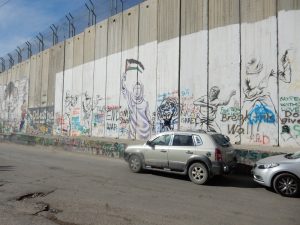 News that you probably have not heard: Today a 17 year old named Qusay Hasna al-Umour was killed by Israeli soldiers in Tuqu, a village just east of Bethlehem. He was 17 years old, throwing stones. He was shot three times, the first bullet to his heart. There is a photo circulating amongst my friends here showing four fully armed soldiers carrying his limp body, one man holding each extremity as if he were an animal, some kind of prey just shot in the wild. This is clearly a blood sport and the IDF are out to kill and maim as many angry, frustrated, hopeless men as possible. The photo reminds many people of a similar episode in the Second Intifada. According to the Ma’an News Agency, the Palestinian Red Crescent claims al-Umour was detained for an unspecified amount of time after he was shot before he was handed over to the Palestinian paramedics for treatment. J Post had the following headline:
News that you probably have not heard: Today a 17 year old named Qusay Hasna al-Umour was killed by Israeli soldiers in Tuqu, a village just east of Bethlehem. He was 17 years old, throwing stones. He was shot three times, the first bullet to his heart. There is a photo circulating amongst my friends here showing four fully armed soldiers carrying his limp body, one man holding each extremity as if he were an animal, some kind of prey just shot in the wild. This is clearly a blood sport and the IDF are out to kill and maim as many angry, frustrated, hopeless men as possible. The photo reminds many people of a similar episode in the Second Intifada. According to the Ma’an News Agency, the Palestinian Red Crescent claims al-Umour was detained for an unspecified amount of time after he was shot before he was handed over to the Palestinian paramedics for treatment. J Post had the following headline:
Border Police shoot and kill Palestinian stone-thrower near Bethlehem
Trolling the internet I find a report by WAFA:
Forces used live ammunition, rubber-coated steel bullets, tear gas canisters, and stun grenades toward residents, shooting and injuring at least five people, including a female, with rubber baton rounds.https://english.wafa.ps/page.aspx?id=DfORbJa52114187268aDfORbJ.
FYI: Stone throwing Israeli youth (read Jews) do not get shot or even arrested for that activity. Their parents are called, maybe there are charges, a lawyer is hired, but their lives are not ruined or extinguished. The racism is screaming at us.
The Al Rowwad Cultural and Arts Center is located in Aida Camp in Bethlehem and we are greeted by Ribal Alkurdi, the energetic executive director, who started as one of the young participants and participated as a dabke dancer for years.
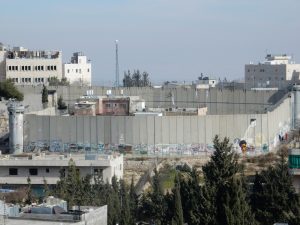 Founded in 1998 in two twelve-meter square rooms, the current building was begun in 2006 with support from groups in Germany through the UNDP and Norway. In 2004, Israelis built the eight meter high concrete wall surrounding the Aida refugee camp and north of the city of Bethlehem. 66% of this camp’s population of about 6,000 is under 24 years of age. There is minimum employment and no room for expansion. Are you feeling like throwing a stone yet?
Founded in 1998 in two twelve-meter square rooms, the current building was begun in 2006 with support from groups in Germany through the UNDP and Norway. In 2004, Israelis built the eight meter high concrete wall surrounding the Aida refugee camp and north of the city of Bethlehem. 66% of this camp’s population of about 6,000 is under 24 years of age. There is minimum employment and no room for expansion. Are you feeling like throwing a stone yet?
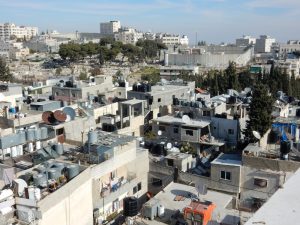
The activities of the center have moved beyond the camp and now reach all of the West Bank, providing benefits to 35,000 children in 2015. In 1998 it was only a theater and in 2000 with the start of the Second Intifada, they began developing many departments including art, theater, dance, music and choir, developing cultural resistance through the arts. There is a women’s program with education, embroidery, artisan crafts, a fitness hall started in 2006 and now servicing 250 women (when trainers are available or affordable). Images for Life is a central program that teaches women and children photography and documentary film making as well as photo development. The educational curriculum offers Arabic, math, and English, volunteers teach classes for one week to three months and there is a creative new library with 3,500 books. The Playbus travels through the West Bank offering the children educational games and enjoyable activities. I look around the jumbled office and on the wall there are quotes from Gandhi, Martin Luther King, Malcolm X, and Nelson Mandela, a very respectable heritage. The work of the center is grounded in “beautiful resistance,” a respect for human rights and the right of return for refugees. The newly renovated library includes a welcoming reading space, educational game area, and computer lab. A smart board and tablets are coming soon.
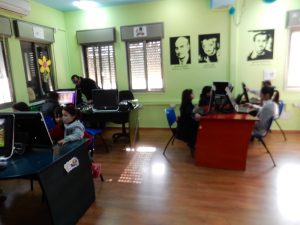
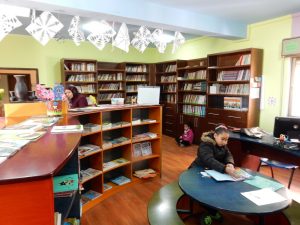
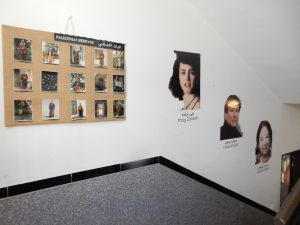
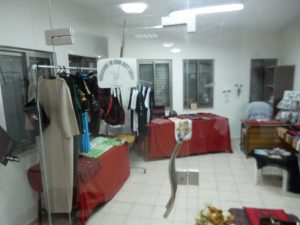
We learn there are two UNRWA schools in the camp, 550 boys and more than 800 girls up to ninth grade. After that students can go to public school or to private school (which is unaffordable for these families). This week is school vacation so the center is filled with boisterous children doing Winter Camp. With the emphasis on Palestinian culture, the walls have paintings of May Ziadah, (Lebanese-Palestinian poet and essayist), Edward Said, (Palestinian-American professor of literature at Columbia who wrote extensively on Orientalism and post-colonial studies), and Fadwa Toqan, (Palestinian poet). We walk into the Image for Life department where women and youth learn how to do photography and documentary filmmaking to chronicle the life in the camp, the impact of the wall, and the yearning for the right of return. We pass a museum with traditional dresses, pottery, and artifacts, a multipurpose women’s fitness hall lined with sewing machines, the main hall for dance and theater, and the gift shop. There is a pile of empty brightly colored pots, part of an UNRWA project to brighten the camp with potted plants. The center has grown impressively since I was last here three years ago.
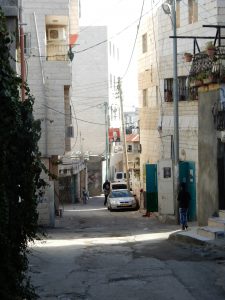
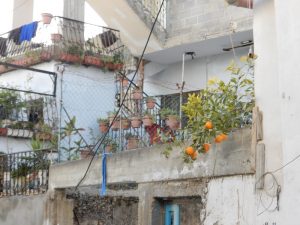
We start a walking tour with Ribal that begins with a stunning bit of information. Residents of the camp have water every 20 days or so for six hours during which time they are able to fill the dense collection of water tanks that crowd every roof. 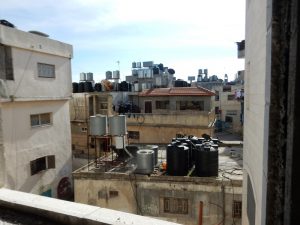
Even with restrictive water usage, there are often two weeks towards the end when there is no water before the central distribution is turned on again. We wend our way down dusty crowded streets with no open green space, hardy trees competing with houses and parked cars; children are everywhere, playing, sitting, bicycling, kicking soccer balls, twirling a sling shot. They are teargassed by the IDF on a daily basis. Is that stone looking more reasonable?
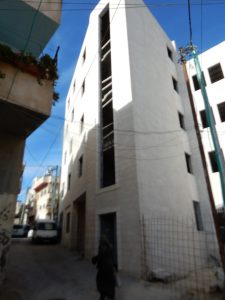
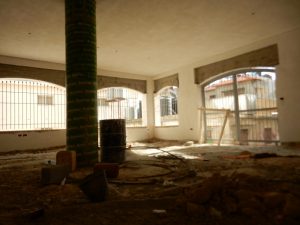
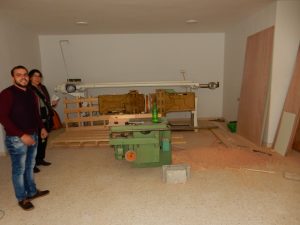
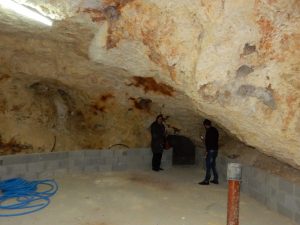
Ribal unlocks a metal door and proudly invites us into an impressive six story construction project, the new building for Al Rowwad. We tour each floor, stepping around rebar and sandy floors and piles of construction materials and roughed out stairways. In the downstairs there is an amazing collection of sophisticated woodworking machinery: a computer controlled machine with a 3-D cutter that can be used for making furniture, games, and puzzles, a panel saw, machinery to mill and sand wood. Someday this will be a training workshop and source of products that can be used in the center as well as a source of income. We go further downstairs into the future museum, an evocative cave that was used by the Palestinian resistance before 1930. Ribal sees a future history and science museum in an imaginative and historical setting. We creep up the unfinished stairs and bear witness to the dreams of the founder Abdelfattah Abusrour: a women’s department and showroom, media department, recording studio, radio by internet (Rowwad194) produced by children less than sixteen years old, computer room, phone repair room, guest house, soup factory, training kitchen that morphs into a restaurant in the afternoon. He envisions vocational training, future employment, cultural and educational opportunities, and women’s empowerment in a self-sustaining center. It is a grand vision that has the potential to change the lives of many residents of the camp and beyond. They need $500,000 to finish the structure and then more to fill it with the necessary furniture and equipment. I wonder, a common battle tank costs $8.5 million, surely the US military wouldn’t miss one of those hulking monsters and think of what these folks could do with that money. A military jet would work just as well. They hope to have the women’s department, guest house, and kitchen finished in 2017. Abdelfattah is in Vienna to receive the (well-deserved) Stars Foundation Impact Award. https://www.starsfoundation.org.uk/blog/2016-stars-impact-award-winners-announced.
We walk onto the roof and look at the tumble of houses, military towers, and the imposing concrete wall that snakes around the camp and through the community.
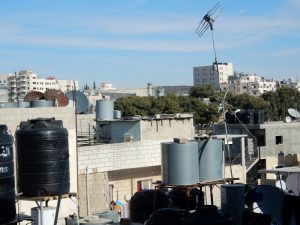
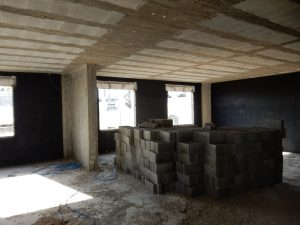
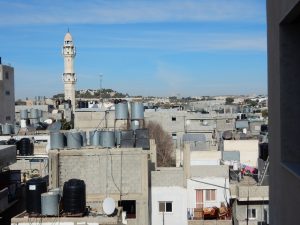
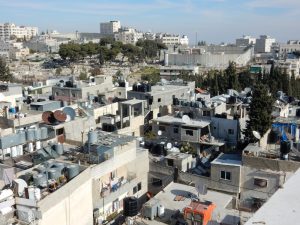
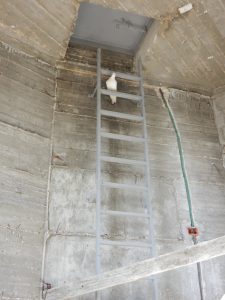 Back in the street, Ribal tells us that of the 538 villages destroyed in 1948, 41 villages are represented in Aida Camp. He, like many from the Abusrour family, is from Beit Natif. They represent one sixth of the camp’s inhabitants. The land was rented by UNRWA for 99 years from a cathedral in Beit Jala. No one knows what will happen when the 99 years is up. Hopefully the occupation will be over before then, but the trends are not that promising.
Back in the street, Ribal tells us that of the 538 villages destroyed in 1948, 41 villages are represented in Aida Camp. He, like many from the Abusrour family, is from Beit Natif. They represent one sixth of the camp’s inhabitants. The land was rented by UNRWA for 99 years from a cathedral in Beit Jala. No one knows what will happen when the 99 years is up. Hopefully the occupation will be over before then, but the trends are not that promising.
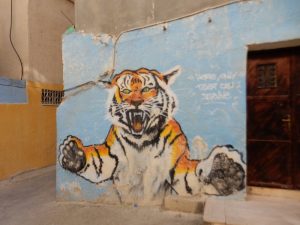 Some of the walls of the homes have been painted bright colors in an attempt to mitigate the grey, over crowded housing. The UNRWA boy’s school is right near the wall and has been repaired ten times since the Second Intifada due to IDF attacks.
Some of the walls of the homes have been painted bright colors in an attempt to mitigate the grey, over crowded housing. The UNRWA boy’s school is right near the wall and has been repaired ten times since the Second Intifada due to IDF attacks.
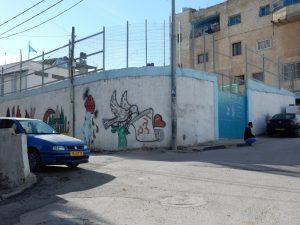
The school finally covered up the windows with sheets of wood but there are still bullet holes in the metal doors. And you ask why children hate the Israeli soldiers?
Shortly we are facing the apartheid wall in all its immense ugliness. The ominous guard tower is blackened and no longer used, but this is the area where the pope was welcomed to Aida Camp in 2009. The Israelis insisted that the performance stage be moved away from the wall as they did not want the international community to see the oppressive concrete as the backdrop, but it is difficult to hide.
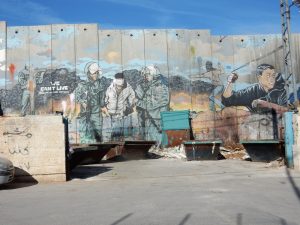
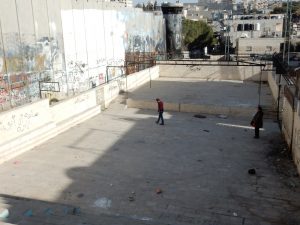
Amongst the towers of burned garbage, the wall looms with its painful and defiant graffiti: “We can’t live, so we are waiting for death,” beside a mural of a blindfolded Palestinian being arrested by two Israeli soldiers. To the right of this is a large mural of a young man with a slingshot aimed at the burned out tower. “One day the sun will shine on a free Palestine,” “We are more powerful than they can possibly imagine.” Much of the graffiti dates back to my last visit in 2014. Not only have conditions not improved, they are in fact getting worse.
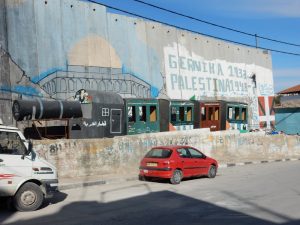 A row of black train cars is parked against the wall; in 2016 the Freedom Train packed with refugees drove from the nearby Deheisha Camp to Rachel’s Tomb where they were met with teargas and bullets. https://972mag.com/photos-palestinian-return-train-is-stopped-at-israels-wall/119356/. Stones anyone?
A row of black train cars is parked against the wall; in 2016 the Freedom Train packed with refugees drove from the nearby Deheisha Camp to Rachel’s Tomb where they were met with teargas and bullets. https://972mag.com/photos-palestinian-return-train-is-stopped-at-israels-wall/119356/. Stones anyone?
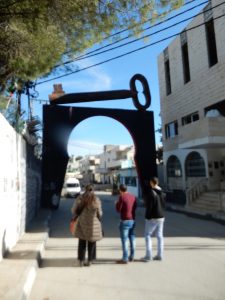
Our tour continues along the wall at the entrance of the camp with its famous enormous metal key symbolizing the right of return for refugees, “nonnegotiable and not for sale.”
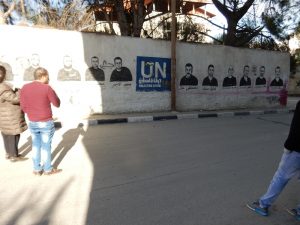
The faces of twelve Palestinian men are painted on the wall, all arrested in the two intifadas, some released during the Shalit prisoner swap, and some still in prison. Adjacent to this is a partial listing of the children killed in the 2014 war on Gaza and then the UNRWA distribution center. From this corner we can stare directly down the street to the apartheid wall and the blue metal gate that opens to let soldiers, jeeps, and tanks invade the camp.
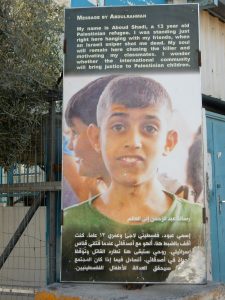
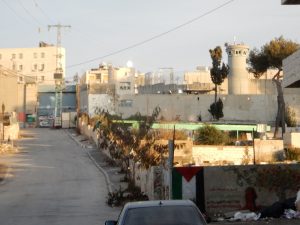
In 2015, thirteen year old Abdul Shadi was standing in the street with his friends when an Israeli sniper lifted his weapon, aimed, and fired, the seventh child of Aida Camp to die since the encirclement by the wall. A poster with his young, slightly goofy, wide eyed face stares from the corner where he died. “My soul will remain here chasing the killer and motivating my classmates. I wonder whether the international community will bring justice to Palestinian children.” And he hadn’t even thrown a stone.
Our next stop is just down the street at the Lagee Center which has programs such as a library, computer lab, cultural tours, recreation, excursions in the West Bank, summer camps, arts, media, and sports.
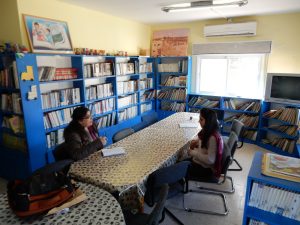
I am particularly interested in their environmental focus, garden and water project. We meet with Amani, the coordinator of activities, who started at the center when she was ten years old and is now studying law and human rights at Al Quds University. She is hopeful that now that Palestinians have state status they will be able to use the International Court to focus attention on the occupation and human rights violations. She tells us of the Our Voice project. Amahl Bishara, a professor at Tufts and a Palestinian with an Israeli ID, organized a visit in 2007 of children under sixteen who do not yet have IDs to travel to Israel, to visit and document the villages of their parent’s and grandparent’s. Amani was fourteen, visited Beit Mahsir which is seven kilometers from here, and still remembers this as a very emotional and defining experience, “Each person has three to four dunams. Now everything is stolen, very depressing.” She visited, the village of the center’s director and brought him back a piece of saber cactus which is now growing wildly at his home in the camp. The Israeli authorities understand this knowledge is dangerous. It is no longer possible to bring children without IDs into Israel, the land their families fled in 1948.
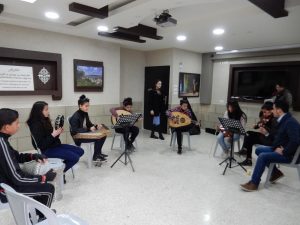 We visit a large room where ten students are diligently playing ouds, qanuns, violins, tambourine and tabla, rehearsing a folkloric Palestinian song with a patient teacher. The musicians and the dabke group have toured in Scotland, Ireland, and England. There is a media unit and a football academy for boys and girls. The soccer team has also played in Scotland.
We visit a large room where ten students are diligently playing ouds, qanuns, violins, tambourine and tabla, rehearsing a folkloric Palestinian song with a patient teacher. The musicians and the dabke group have toured in Scotland, Ireland, and England. There is a media unit and a football academy for boys and girls. The soccer team has also played in Scotland.
We are particularly interested in the Lagee environmental programs and the gardens, playground, and soccer field that were developed with support from a US group, 1for3.org, and we are joined by Shatha Alazzeh, the lively and focused director of the Environmental Unit. 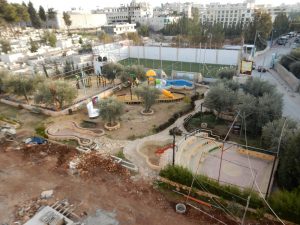 She also started as a volunteer, began studying biology and medical science in university, and started collecting water samples in the Aida Camp as part of a project with Tufts University graduate students. After her BA she started working full time at Lajee. She now has twenty students, ages thirteen to fifteen, involved in science and environmental lectures, recycling organic and nonorganic material and creating compost. The latter two are very strange ideas in Palestine which is littered with plastic bags, tires, and garbage and minimal to no garbage collection. They are also working on a project to build rooftop greenhouses in order to build food security as there is no space for gardens in the camp which is 0.71 square kilometers.
She also started as a volunteer, began studying biology and medical science in university, and started collecting water samples in the Aida Camp as part of a project with Tufts University graduate students. After her BA she started working full time at Lajee. She now has twenty students, ages thirteen to fifteen, involved in science and environmental lectures, recycling organic and nonorganic material and creating compost. The latter two are very strange ideas in Palestine which is littered with plastic bags, tires, and garbage and minimal to no garbage collection. They are also working on a project to build rooftop greenhouses in order to build food security as there is no space for gardens in the camp which is 0.71 square kilometers.
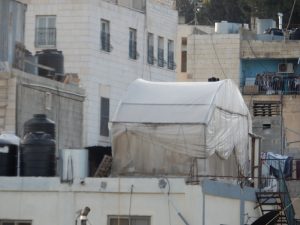 There are now ten greenhouses feeding fourteen families. She takes the children on educational field trips to cities and villages in areas A and B to explore the biodiversity in Palestine.
There are now ten greenhouses feeding fourteen families. She takes the children on educational field trips to cities and villages in areas A and B to explore the biodiversity in Palestine.
The water testing project extends to four refugee camps and Aida was found to have contamination with e coli. This is complicated by episodes like last month when the IDF soldiers deliberately put sewerage in the water lines. 75% of their water is bought from the semiprivate company Mekerot and 25% is from the Palestinian Authority. Palestinians are not allowed to dig wells or collect rainwater in a well. In the summer they tend to have six hours of water every three weeks or so, the camp is divided into four areas which have to fill sequentially. Besides an inadequate supply and issues around contamination, the water pipes are fifty years old and sometimes mix with sewerage. The Lagee center has created educational brochures about water quality, cleaning the tanks, disinfecting the water supply, adding chlorine tablets and now the water quality is markedly improved. The water project includes collecting rain water from roofs into a cisterns, filtering the water and then distributing the water to homes via a water truck. The program will be operational in 2017.
The Israeli authorities do not allow the Palestinian Authority to have waste water treatment plants so the waste water is transferred to the Wadi Nar valley where it is treated and used by Israelis. In another example of water policy as a weapon, the nearby Jewish settlement of Gilo dumps its waste water into the camp near the wall where the children play and in front of the Lagee Center. Shatha also notes that the repeated spraying of putrid skunk water, (which the Israelis claim is nontoxic, organic, and even drinkable), has killed all the trees in front of the center.
Shatha was born in the nearby Askar Refugee Camp and moved to Aida when she got married. The IDF arrested her husband two weeks after the wedding and held him for four months, accusing him of making a political statement on Facebook. She traveled 14 hours for a 45 minute to visit him. “We had a honeyjail not a honeymoon.” She describes her husband being beaten by the soldiers and her desire to stay strong in front of them. “My story is nothing.” She witnessed little children visiting their fathers’ in prison and crying because they could not touch their hands.
Shatha has a masters in environmental studies and trained for one semester in Sweden, “The first time in my life to see the sea.” When she explained she was from Palestine, Swedes would look at her funny and say, “Where? Pakistan?” She adds, “It is important to change, the culture, the bad things, to bring the generation to be environmentally friendly.” She was working in the Lajee summer camp for children and only when she threatened to spy on them and fine them, did they stop throwing trash in the garden. Old patterns are hard to change, but she is inspirational. “We want Palestine to be clean, first clean from occupation, and a new generation thinking environmentally friendly.”
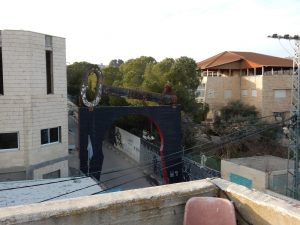
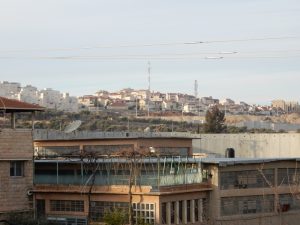
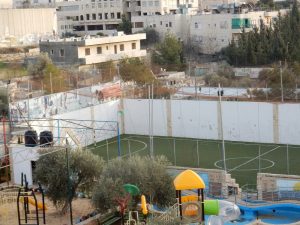
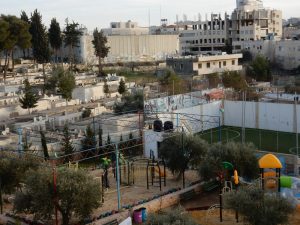
On the roof of the center we can see the Jewish settlement of Gilo, the winding concrete wall, six military towers; 23 surveillance cameras keeping close watch on the 6,000 refugees imprisoned within. By contrast, the garden and playground below is a breath of fresh air, brightly colored, appealing, and bordered by a soccer field that has netting to protect the children from tear gas canisters. Brightly painted recycled tires form a border. Between the playground and field and the ominous guard tower and wall is the cemetery where those who have finally given up can have a moment of peace. On the roofs we can see three large plastic greenhouses.
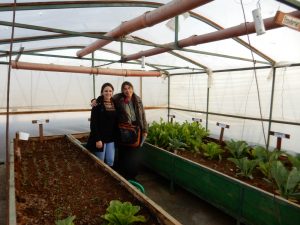
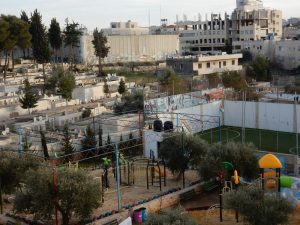
In the front of the center we spot the main cistern for the camp that holds the water from Bethlehem. On a nearby wall are 33 martyrs killed since the First Intifada. Shatha explains that five hundred men and four women have been arrested by the IDF since the Intifada. Resistance and death are everywhere. She takes us past a mural which documents the modern history of Palestine; reminding us that children must never forget.
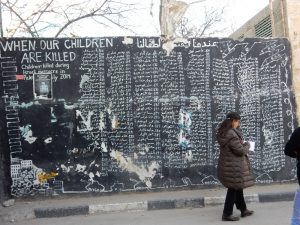
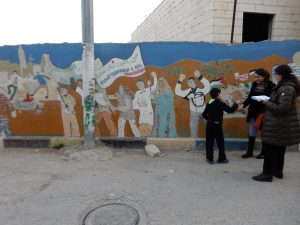
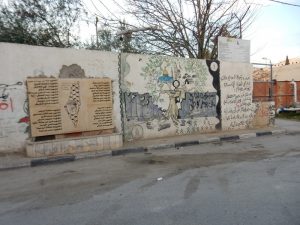
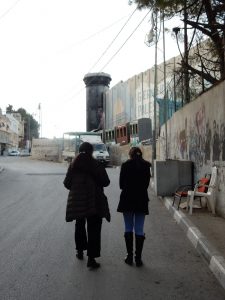
for more information from previous blogs:
https://alicerothchild.com/2014/06/the-tigers-the-butterflies-and-the-birds-june-19-2014/)